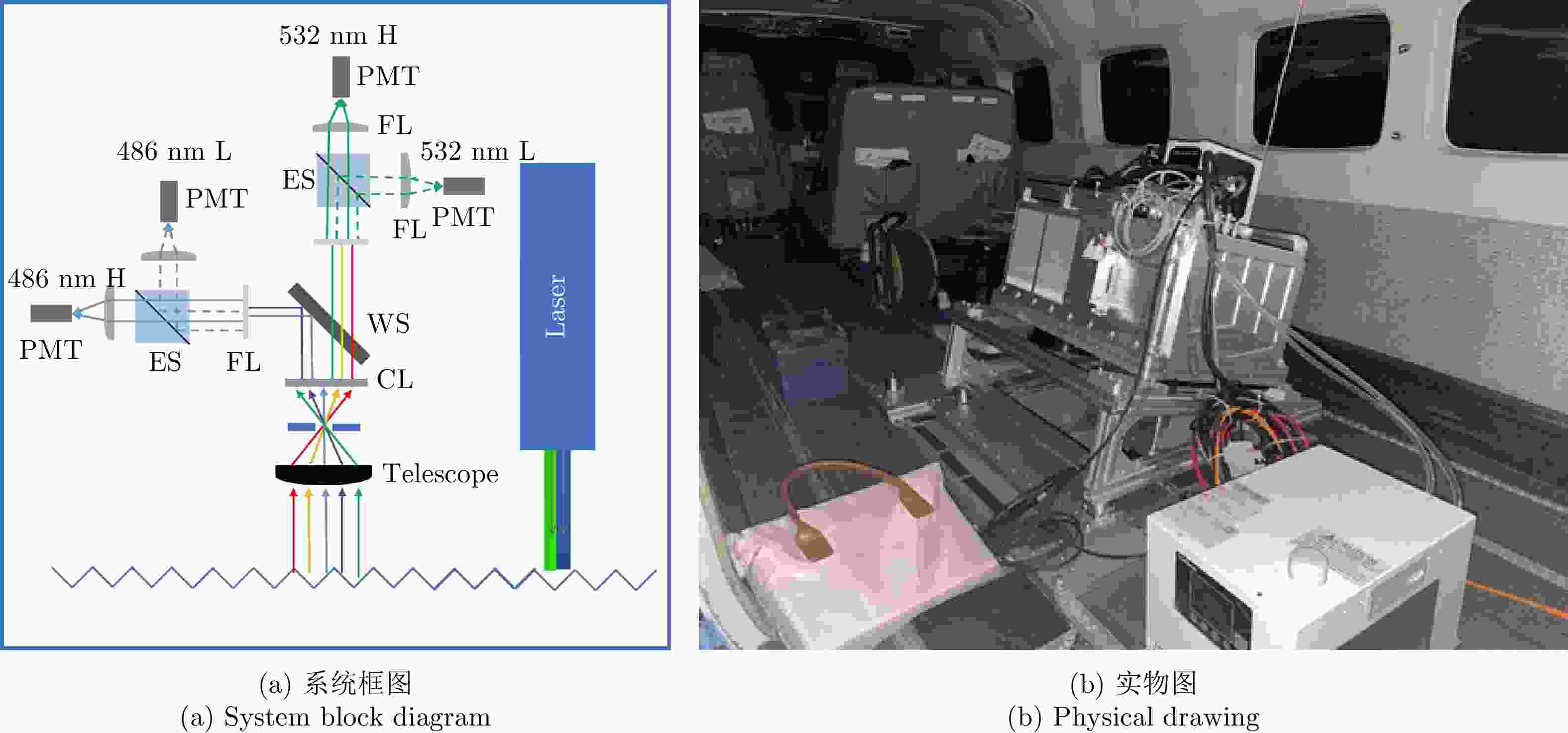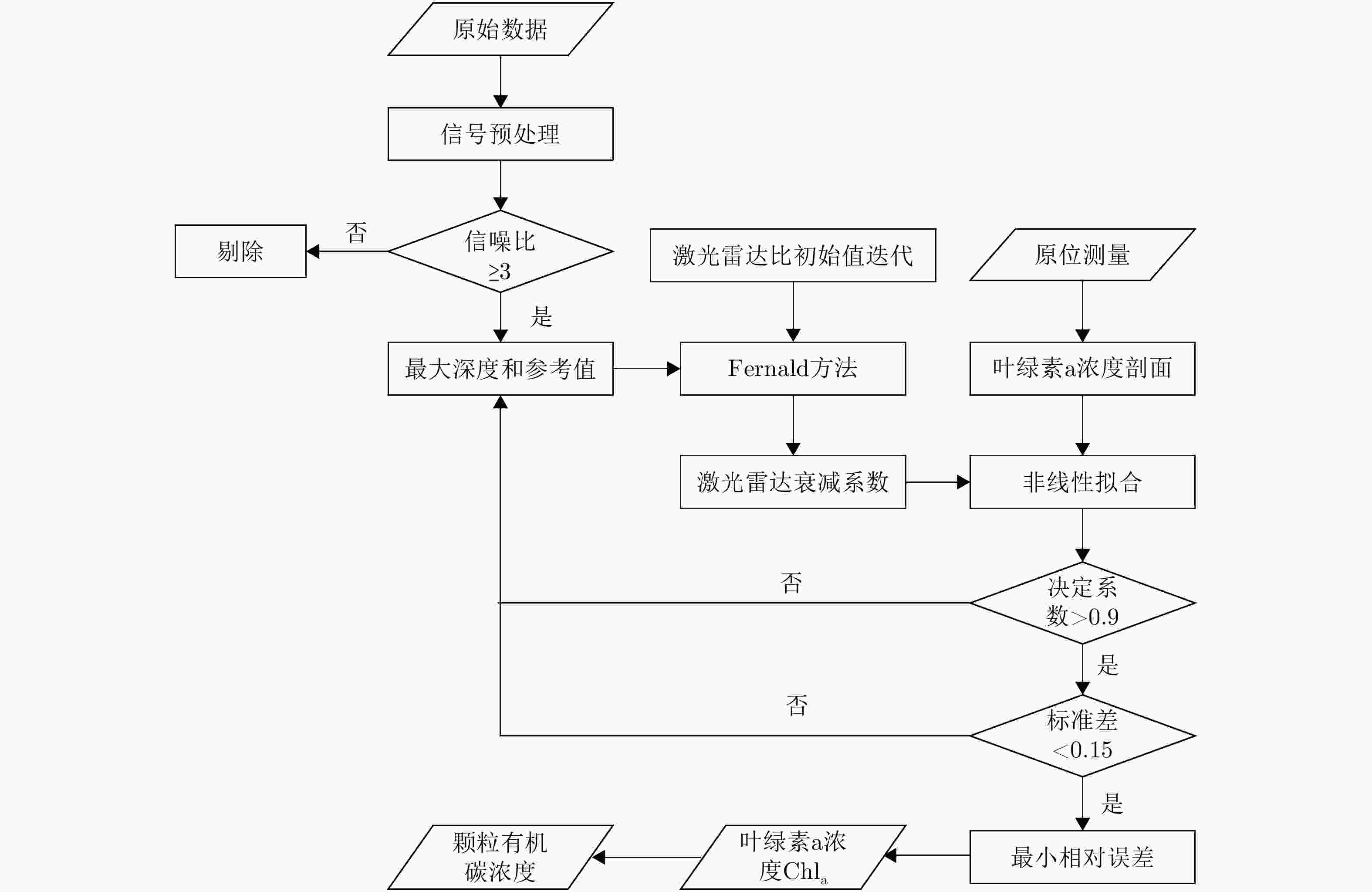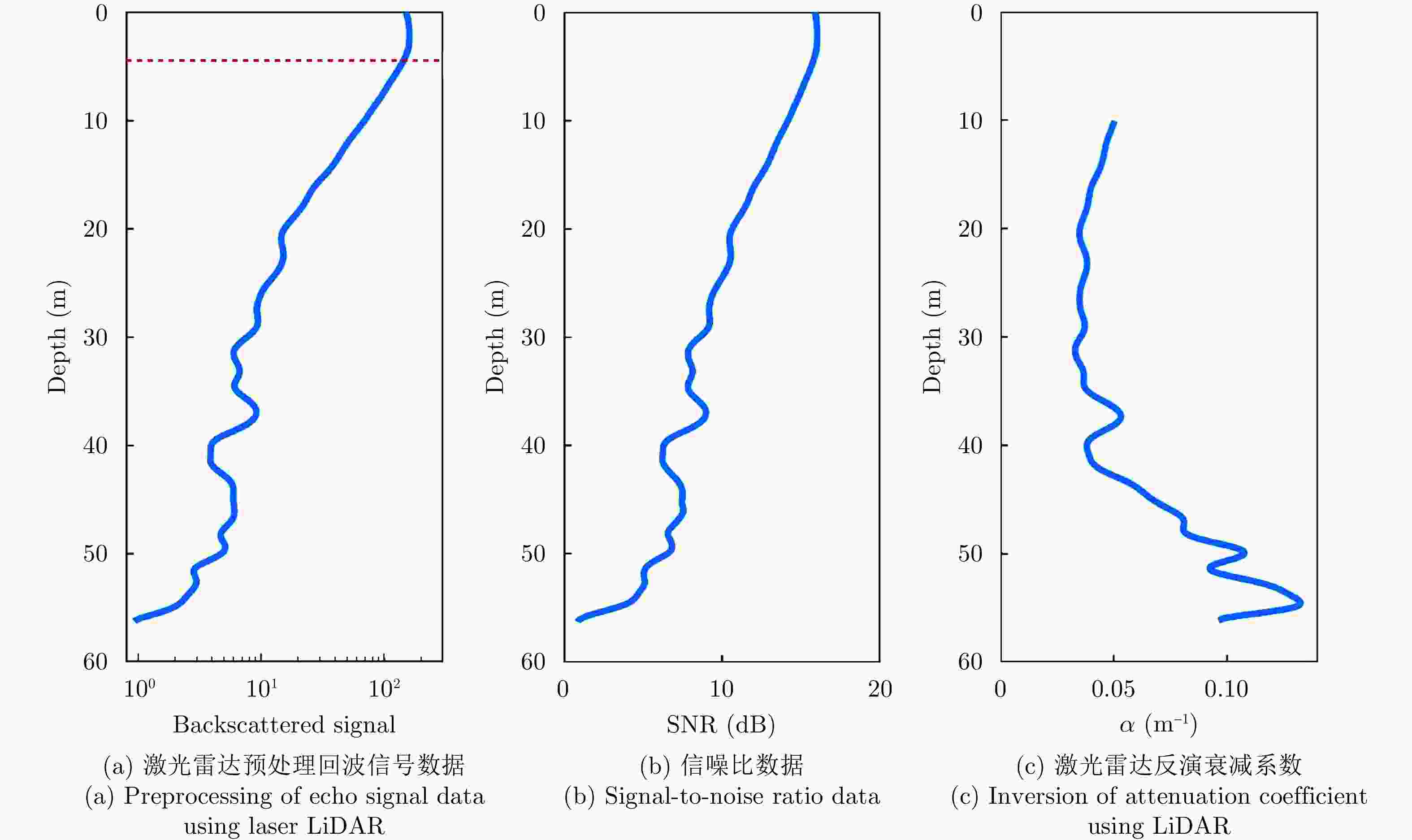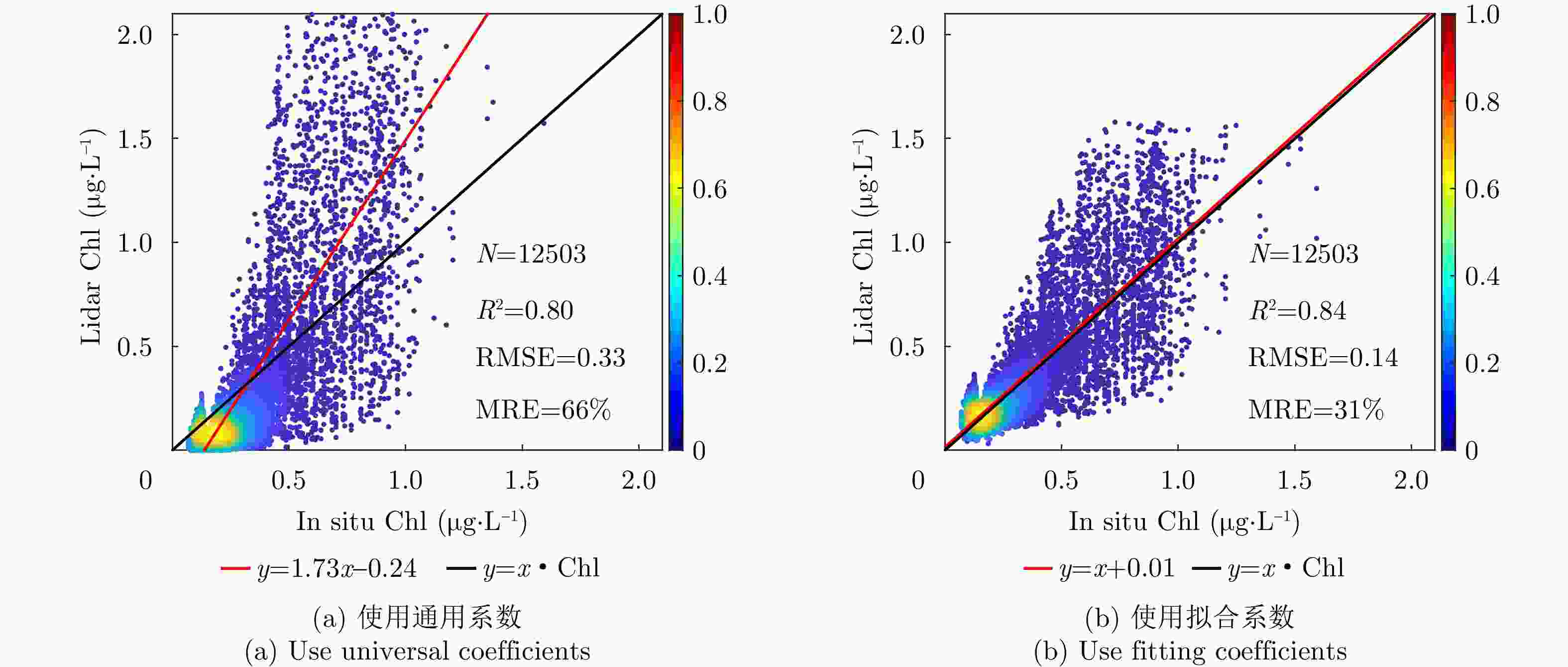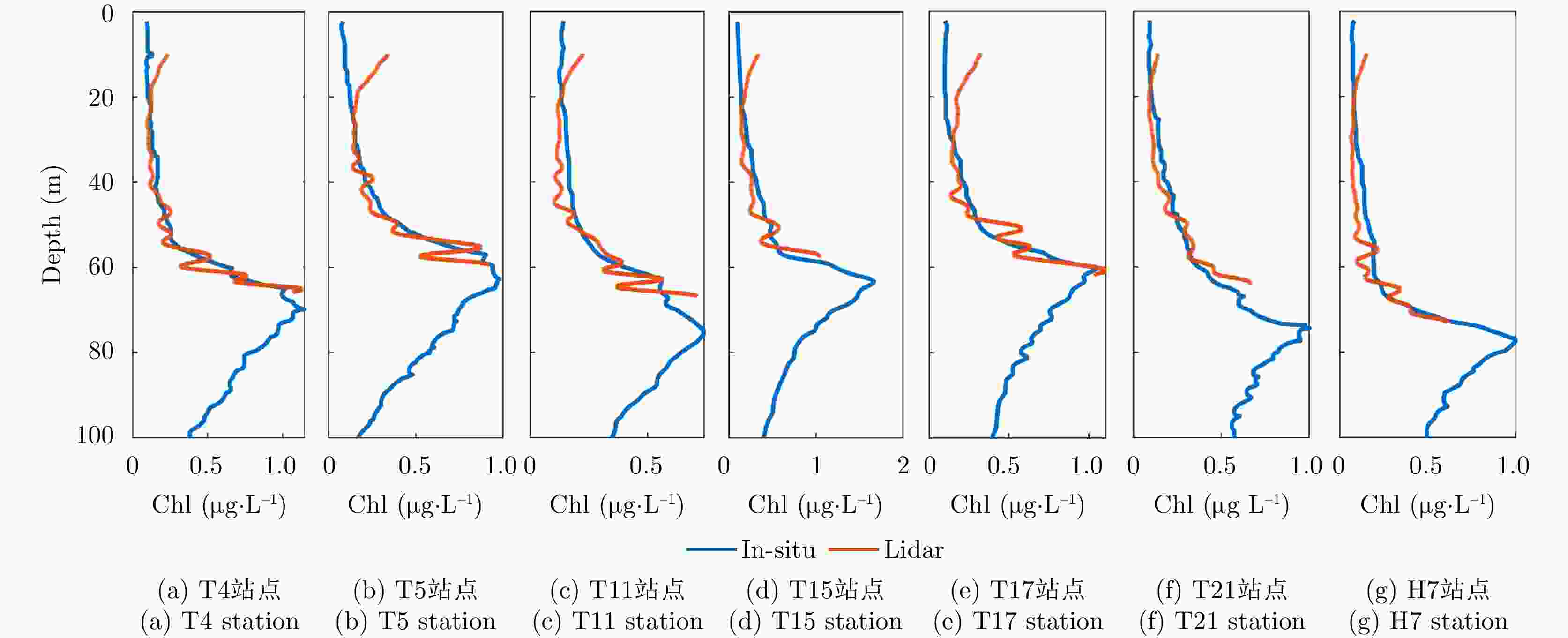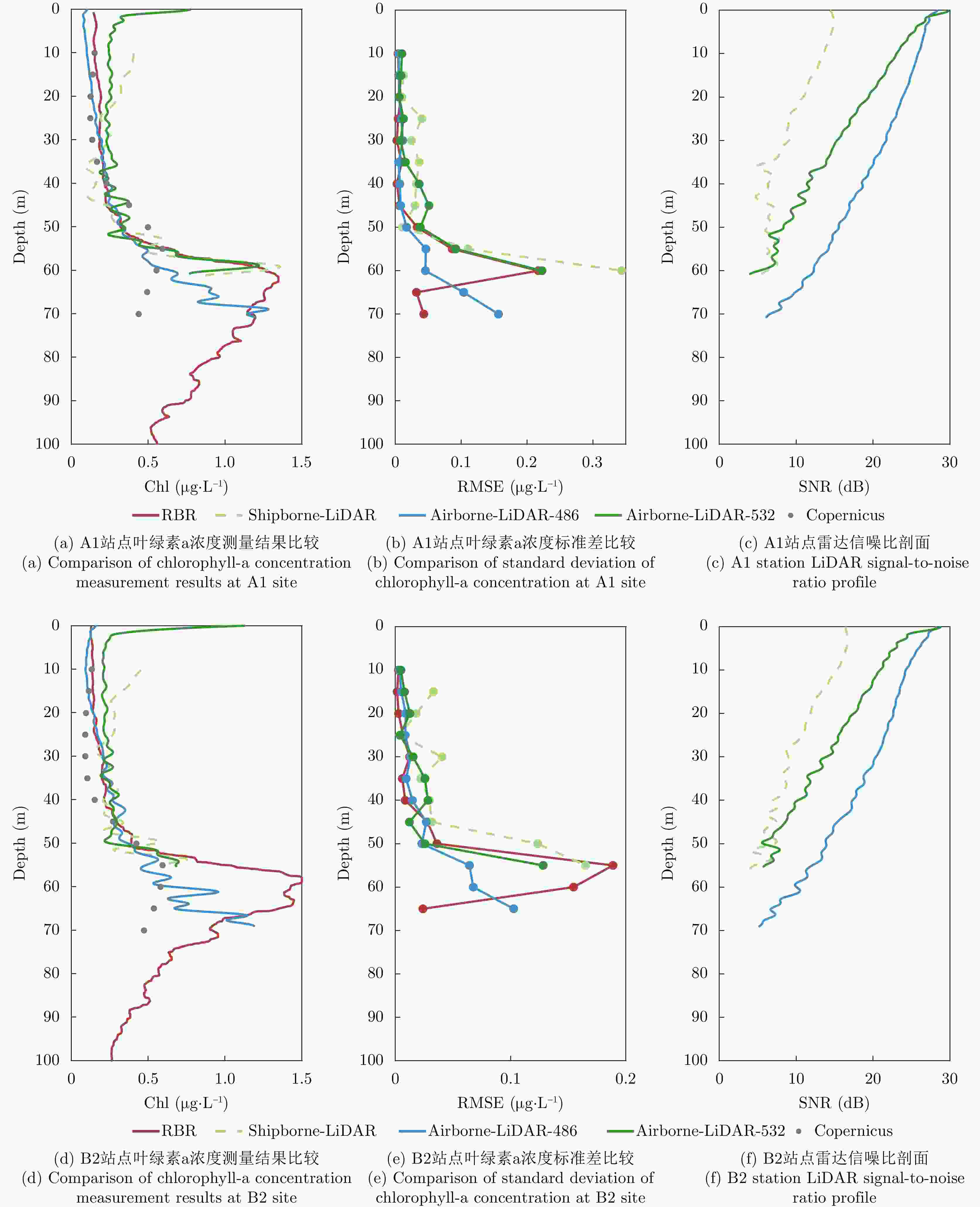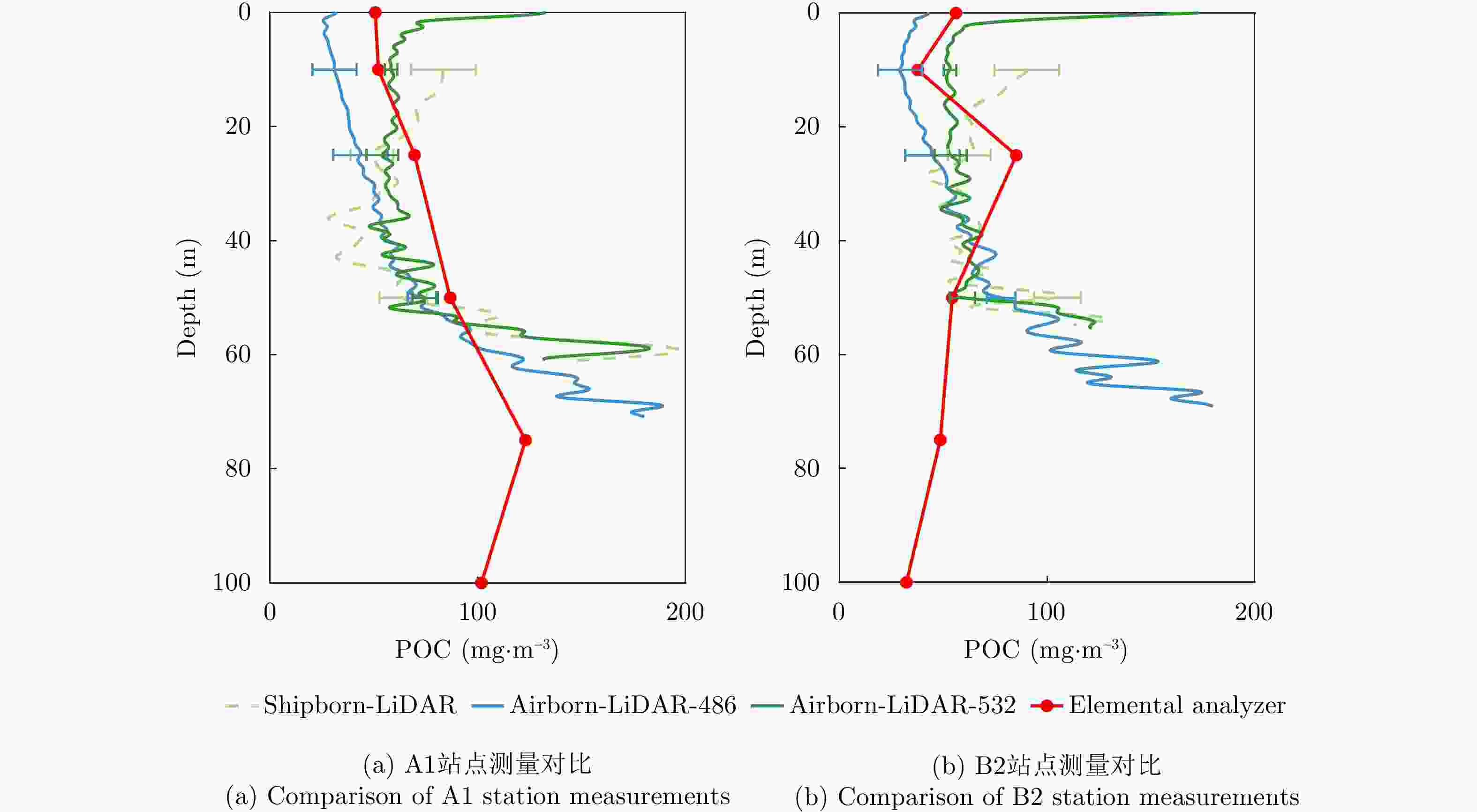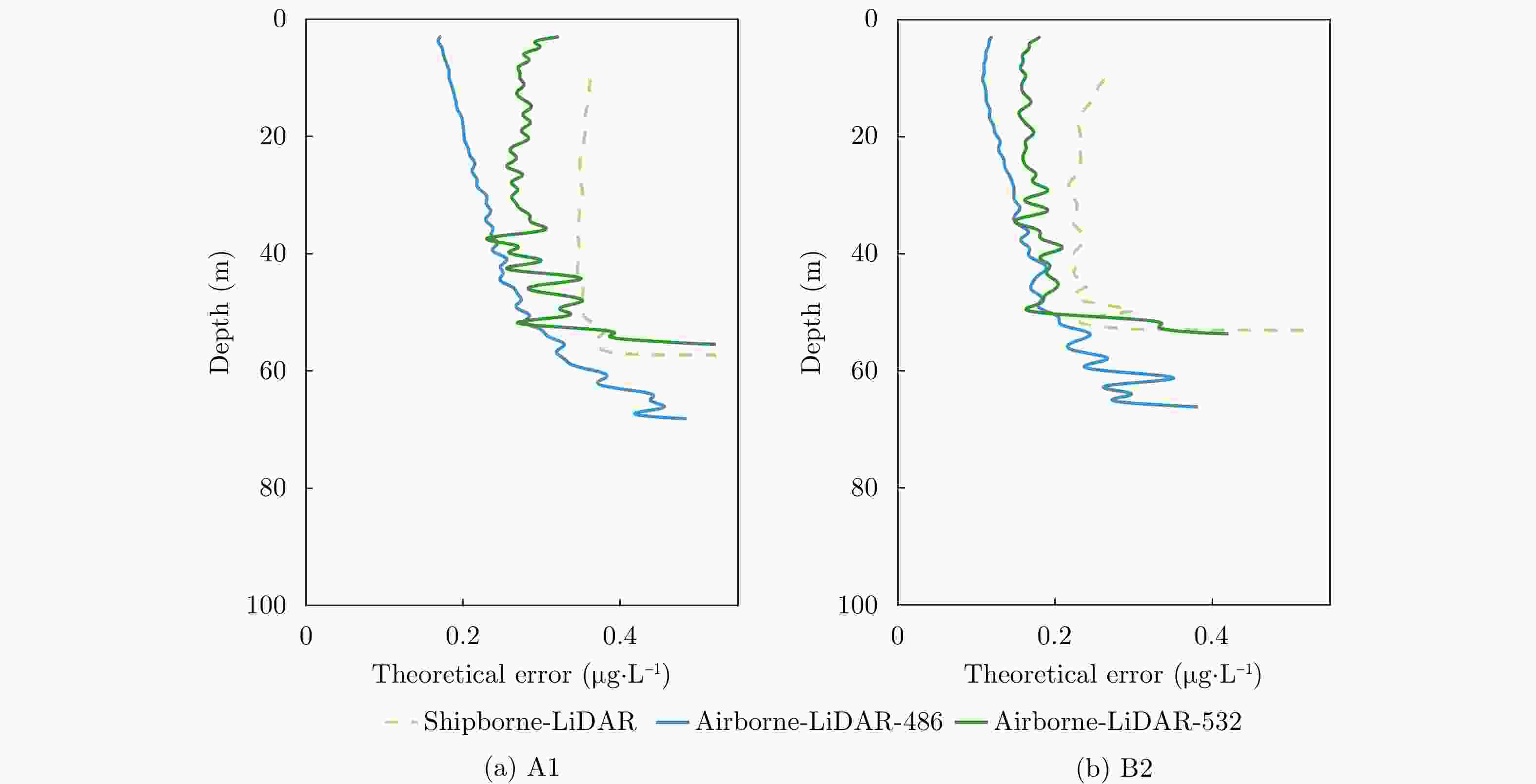Inversion and Validation of Ocean Surface Bio-optical Parameters Using Multiplatform Ocean LiDAR
-
摘要: 海洋上表层生物光学参数的垂直特征对评估海洋初级生产力和碳循环至关重要。虽然激光雷达技术能够有效探测这些参数,但受限于经验模型在不同区域的适应性差异,反演结果通常存在较大偏差。针对该问题,该研究基于2023—2024年中国某海域多平台激光雷达联合观测数据,结合区域适应性生物光学模型,实现了该海域生物光学参数剖面的高精度反演。其中,叶绿素a浓度剖面反演结果与原位数据一致性较高,决定系数(R2)为0.84,平均均方根误差(RMSE)为0.14 μg·L–1。通过误差传递模型量化分析表明,不同波段的光学敏感性差异显著影响误差分布,蓝光波段有效探测深度为70 m,显著高于绿光波段的58 m。蓝光波段在次表层叶绿素最大值层(SCML)的自身反演偏差较绿光波段低0.18 μg·L–1,进而阐明了各波段光学特性与自身偏差的内在关联,为提升复杂水体生物光学参数剖面反演的可靠性和开展误差分析提供了有效方法。Abstract: The vertical characteristics of biological optical parameters in the upper ocean are essential for evaluating marine primary productivity and the carbon cycle. Although ocean lidar can effectively detect these parameters, the inversion results are usually highly biased due to the regional differences in the adaptability of empirical models. This study uses multiplatform LiDAR observations collected in a certain sea area of China (2023–2024), combined with a region-adaptive bio-optical model, to achieve high-precision profiling of bio-optical parameters in the region. The derived vertical profiles of chlorophyll-a concentration showed strong agreement with in-situ measurements, with a coefficient of determination (R2) of 0.84 and an average root mean square error of 0.14 μg·L–1. Further quantitative analysis using an error transfer model revealed that differences in band-specific optical sensitivity considerably affected error distribution. The effective detection depth in the blue band was 70 m, notably higher than the 58 m depth in the green band. In addition, at the subsurface chlorophyll maximum layer, the inversion bias in the blue band was 0.18 μg·L–1 lower than that in the green band, highlighting the intrinsic relationship between the optical characteristics of each wavelength and its associated bias. This result provides an effective method for improving the reliability of profile inversion of bio-optical parameters in complex waters and performing error analysis.
-
Key words:
- Ocean LiDAR /
- Laser detection /
- Bio-optical parameters /
- Blue-green wave band /
- Error analysis
-
图 7 典型站点的船载与机载海洋激光雷达反演的叶绿素a浓度剖面与原位RBR测量结果比较、标准差比较以及相应的信噪比剖面
Figure 7. Comparison of chlorophyll-a concentration profiles inverted by shipborne and airborne ocean LiDAR at typical sites with in-situ RBR measurement results, standard deviation comparison, and corresponding signal-to-noise ratio profiles
表 1 船载雷达系统参数表
Table 1. Parameter table of shipboard LiDAR system
分系统 参数 描述 发射
系统单脉冲能量 200 mJ @ 532 nm;
120 mJ @ 355 nm;400 mJ @ 1064 nm重复频率 20 Hz 脉宽 ≤ 5 ns 发散角 ≤ 0.5 mrad 光束直径 ≈ 6.5 mm 接收
系统望远镜直径 60 mm 视场 16~60 mrad 滤色片 1 nm @ 532 nm;
3 nm @ 355 nm, 405 nm;
10 nm @ 680 nm探测器 Photomultiplier tube 采集
系统AD分辨率 14 bits 采样频率 PC @ 1 GHz 表 2 机载雷达系统参数表
Table 2. Parameter table of airborne LiDAR system
分系统 参数 描述 发射
系统单脉冲能量 2 mJ @ 486.1 nm;
5 mJ @ 532.2 nm重复频率 100 Hz 脉宽 2.5 ns @ 486.1 nm;
6 ns @ 532.2 nm发散角 5 mrad 接收
系统望远镜直径 200 mm 视场 28 mrad 接收光学带宽 0.44 nm @ 486.1 nm;
0.60 nm @ 532.2 nm探测器 Photomultiplier tube 采集系统 采样频率 1 ns 表 3 试验区域两个航次的站点信息表
Table 3. Station information table for two cruises in the test area
航次 站点 位置 2023年4月 T4 114°19'E, 18°27'N T5 114°36'E, 18°50'N T7 115°05'E, 19°12'N T9 115°20'E, 19°35'N T11 115°27'E, 19°46'N T13 115°17'E, 19°28'N T15 115°00'E, 18°55'N T17 114°37'E, 18°36'N T19 114°20'E, 18°20'N T21 111°30'E, 18°00'N H7 111°28'E, 18°00'N 2024年5月 A1 110°41'E, 17°51'N B2 111°05'E, 17°20'N 表 4 辅助参数说明
Table 4. Auxiliary parameter description
数据来源 参数 说明 RBR水质监测仪
(RBR XR-420, RBR, Canada)Chla 叶绿素a浓度剖面 Global Ocean Biogeochemistry
Analysis and ForecastChla 叶绿素a浓度剖面 元素分析仪(UNICUBE, Elementar,
germany)POC 颗粒有机碳浓度 -
[1] BEHRENFELD M J and BOSS E. Beam attenuation and chlorophyll concentration as alternative optical indices of phytoplankton biomass[J]. Journal of Marine Research, 2006, 64(3): 431–451. doi: 10.1357/002224006778189563. [2] BREWIN R J W, DALL’OLMO G, PARDO S, et al. Underway spectrophotometry along the Atlantic Meridional Transect reveals high performance in satellite chlorophyll retrievals[J]. Remote Sensing of Environment, 2016, 183: 82–97. doi: 10.1016/j.rse.2016.05.005. [3] LE Chengfeng, ZHOU Xueying, HU Chuanmin, et al. A color-index-based empirical algorithm for determining particulate organic carbon concentration in the ocean from satellite observations[J]. Journal of Geophysical Research: Oceans, 2018, 123(10): 7407–7419. doi: 10.1029/2018JC014014. [4] DICKEY T, LEWIS M, and CHANG G. Optical oceanography: Recent advances and future directions using global remote sensing and in situ observations[J]. Reviews of Geophysics, 2006, 44(1): RG1001. doi: 10.1029/2003RG000148. [5] VASILKOV A P, GOLDIN Y A, GUREEV B A, et al. Airborne polarized lidar detection of scattering layers in the ocean[J]. Applied Optics, 2001, 40(24): 4353–4364. doi: 10.1364/AO.40.004353. [6] COLLISTER B L, ZIMMERMAN R C, SUKENIK C I, et al. Remote sensing of optical characteristics and particle distributions of the upper ocean using shipboard lidar[J]. Remote Sensing of Environment, 2018, 215: 85–96. doi: 10.1016/j.rse.2018.05.032. [7] CHEN Peng and PAN Delu. Ocean optical profiling in South China Sea using airborne LiDAR[J]. Remote Sensing, 2019, 11(15): 1826. doi: 10.3390/rs11151826. [8] LIU Qi, WU Songhua, LIU Bingyi, et al. Shipborne variable-FOV, dual-wavelength, polarized ocean lidar: Design and measurements in the Western Pacific[J]. Optics Express, 2022, 30(6): 8927–8948. doi: 10.1364/OE.449554. [9] YUAN Dapeng, MAO Zhihua, CHEN Peng, et al. Remote sensing of seawater optical properties and the subsurface phytoplankton layer in coastal waters using an airborne multiwavelength polarimetric ocean lidar[J]. Optics Express, 2022, 30(16): 29564–29583. doi: 10.1364/OE.463146. [10] ZHANG Kai, CHEN Yatong, ZHAO Hongkai, et al. Comprehensive, continuous, and vertical measurements of seawater constituents with triple-field-of-view high-spectral-resolution lidar[J]. Research, 2023, 6: 0201. doi: 10.34133/research.0201. [11] SHANGGUAN Mingjia, LIAO Zhuoyang, GUO Yirui, et al. Sensing the profile of particulate beam attenuation coefficient through a single-photon oceanic Raman lidar[J]. Optics Express, 2023, 31(16): 25398–25414. doi: 10.1364/OE.493660. [12] SHANGGUAN Mingjia, GUO Yirui, and LIAO Zhuoyang. Shipborne single-photon fluorescence oceanic lidar: Instrumentation and inversion[J]. Optics Express, 2024, 32(6): 10204–10218. doi: 10.1364/OE.515477. [13] ZHAO Hongkai, ZHOU Yudi, GU Qiuling, et al. Lidar-observed diel vertical variations of inland chlorophyll a concentration[J]. Remote Sensing, 2024, 16(19): 3579. doi: 10.3390/rs16193579. [14] SANG Xuan, MAO Zhihua, LI Youzhi, et al. Observations of optical properties and chlorophyll-a concentration in Qiandao Lake using shipborne lidar[J]. Remote Sensing, 2024, 16(24): 4663. doi: 10.3390/rs16244663. [15] LI Xinye, CHEN Peng, ZHANG Zhenhua, et al. Vertical structure observation from spaceborne lidar ICESat-2 in East China Sea[J]. Optics Express, 2025, 33(2): 2847–2865. doi: 10.1364/OE.540111. [16] ZHU Peizhi, TANG Junwu, SONG Xiaoquan, et al. Future spaceborne oceanographic lidar: Exploring the effects of large off-nadir angles on signal dynamic range and depth aliasing[J]. IEEE Transactions on Geoscience and Remote Sensing, 2025, 63: 5701711. doi: 10.1109/TGRS.2025.3545669. [17] ZHOU Yudi, CHEN Weibiao, CUI Xiaoyu, et al. Validation of the analytical model of oceanic lidar returns: Comparisons with Monte Carlo simulations and experimental results[J]. Remote Sensing, 2019, 11(16): 1870. doi: 10.3390/rs11161870. [18] HE Huixin, LIU Qi, TANG Junwu, et al. Validation of the polarized Monte Carlo model of shipborne oceanic lidar returns[J]. Optics Express, 2023, 31(26): 43250–43268. doi: 10.1364/OE.511445. [19] CHEN Su, CHEN Peng, DING Lei, et al. A new semi-analytical mc model for oceanic LIDAR inelastic signals[J]. Remote Sensing, 2023, 15(3): 684. doi: 10.3390/rs15030684. [20] LIU Qun, LIU Dong, BAI Jian, et al. Relationship between the effective attenuation coefficient of spaceborne lidar signal and the IOPs of seawater[J]. Optics Express, 2018, 26(23): 30278–30291. doi: 10.1364/OE.26.030278. [21] LIU Qun, CUI Xiaoyu, CHEN Weibiao, et al. A semianalytic Monte Carlo radiative transfer model for polarized oceanic lidar: Experiment-based comparisons and multiple scattering effects analyses[J]. Journal of Quantitative Spectroscopy and Radiative Transfer, 2019, 237: 106638. doi: 10.1016/j.jqsrt.2019.106638. [22] ZHOU Yudi, CHEN Yang, ZHAO Hongkai, et al. Shipborne oceanic high-spectral-resolution lidar for accurate estimation of seawater depth-resolved optical properties[J]. Light: Science & Applications, 2022, 11(1): 261. doi: 10.1038/s41377-022-00951-0. [23] CHEN Yatong, CUI Xiaoyu, GU Qiuling, et al. This is MATE: A multiple scAttering correcTion rEtrieval algorithm for accurate lidar profiling of seawater optical properties[J]. Remote Sensing of Environment, 2024, 307: 114166. doi: 10.1016/j.rse.2024.114166. [24] ZHANG Zhenhua, CHEN Peng, MAO Zhihua, et al. A novel fast multiple-scattering approximate model for oceanographic lidar[J]. Remote Sensing, 2021, 13(18): 3677. doi: 10.3390/rs13183677. [25] COLLIS R T H and RUSSELL P B. Lidar Measurement of Particles and Gases by Elastic Backscattering and Differential Absorption[M]. HINKLEY E D. Laser Monitoring of the Atmosphere. Berlin, Heidelberg: Springer, 1976: 71–151. doi: 10.1007/3-540-07743-X_18. [26] KLETT J D. Stable analytical inversion solution for processing lidar returns[J]. Applied Optics, 1981, 20(2): 211–220. doi: 10.1364/AO.20.000211. [27] FERNALD F G, HERMAN B M, and REAGAN J A. Determination of aerosol height distributions by lidar[J]. Journal of Applied Meteorology, 1972, 11(3): 482–489. doi: 10.1175/1520-0450(1972)011<0482:DOAHDB>2.0.CO;2. [28] MOREL A and MARITORENA S. Bio-optical properties of oceanic waters: A reappraisal[J]. Journal of Geophysical Research: Oceans, 2001, 106(C4): 7163–7180. doi: 10.1029/2000JC000319. [29] GORDON H R. Interpretation of airborne oceanic lidar: Effects of multiple scattering[J]. Applied Optics, 1982, 21(16): 2996–3001. doi: 10.1364/AO.21.002996. [30] WALKER R E and MCLEAN J W. Lidar equations for turbid media with pulse stretching[J]. Applied Optics, 1999, 38(12): 2384–2397. doi: 10.1364/AO.38.002384. [31] CHEN Peng, PAN Delu, MAO Zhihua, et al. Semi-analytic Monte Carlo radiative transfer model of laser propagation in inhomogeneous sea water within subsurface plankton layer[J]. Optics & Laser Technology, 2019, 111: 1–5. doi: 10.1016/j.optlastec.2018.09.028. [32] CHEN Peng, JAMET C, MAO Zhihua, et al. OLE: A novel oceanic lidar emulator[J]. IEEE Transactions on Geoscience and Remote Sensing, 2021, 59(11): 9730–9744. doi: 10.1109/TGRS.2020.3035381. [33] SON Y B, GARDNER W D, MISHONOV A V, et al. Multispectral remote-sensing algorithms for particulate organic carbon (POC): The Gulf of Mexico[J]. Remote Sensing of Environment, 2009, 113(1): 50–61. doi: 10.1016/j.rse.2008.08.011. [34] TELLINGHUISEN J. Statistical error propagation[J]. The Journal of Physical Chemistry A, 2001, 105(15): 3917–3921. doi: 10.1021/jp003484u. -



 作者中心
作者中心 专家审稿
专家审稿 责编办公
责编办公 编辑办公
编辑办公
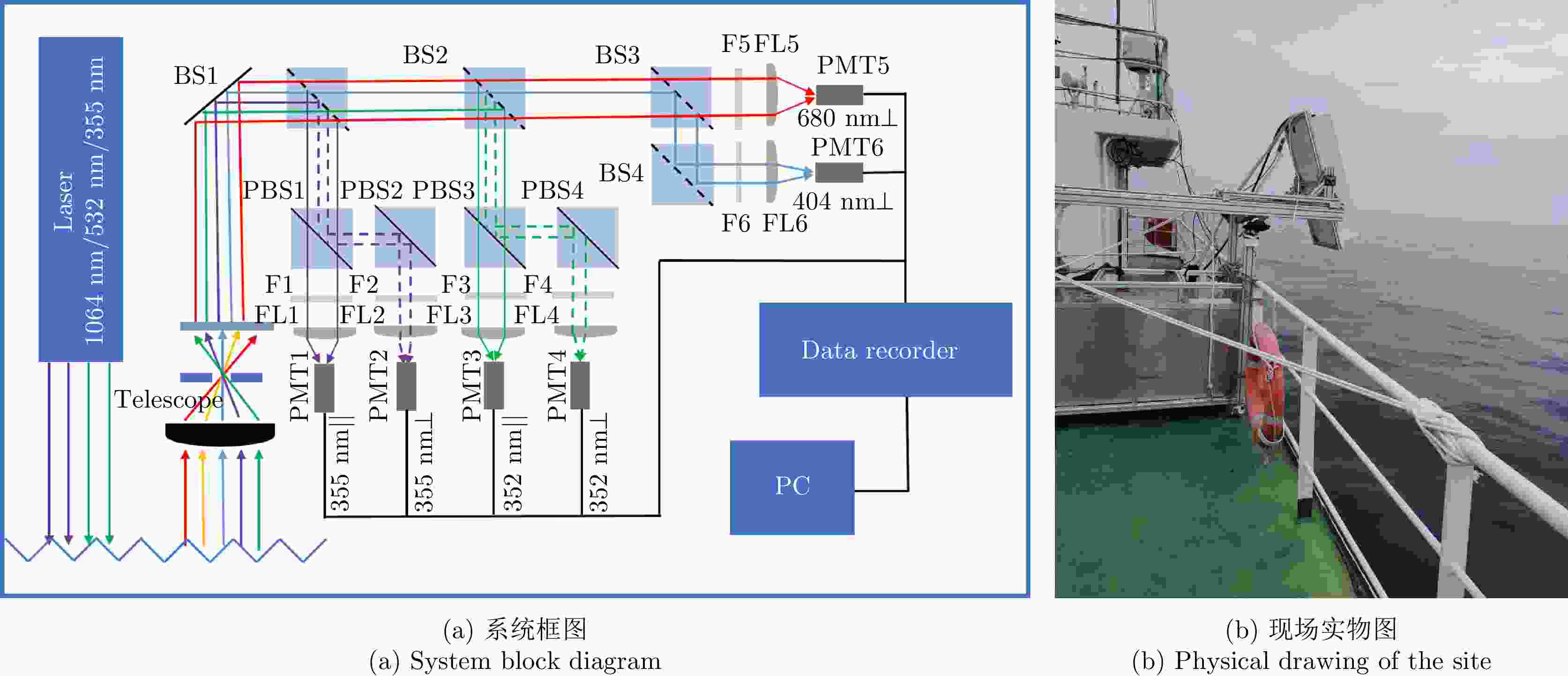
 下载:
下载:
